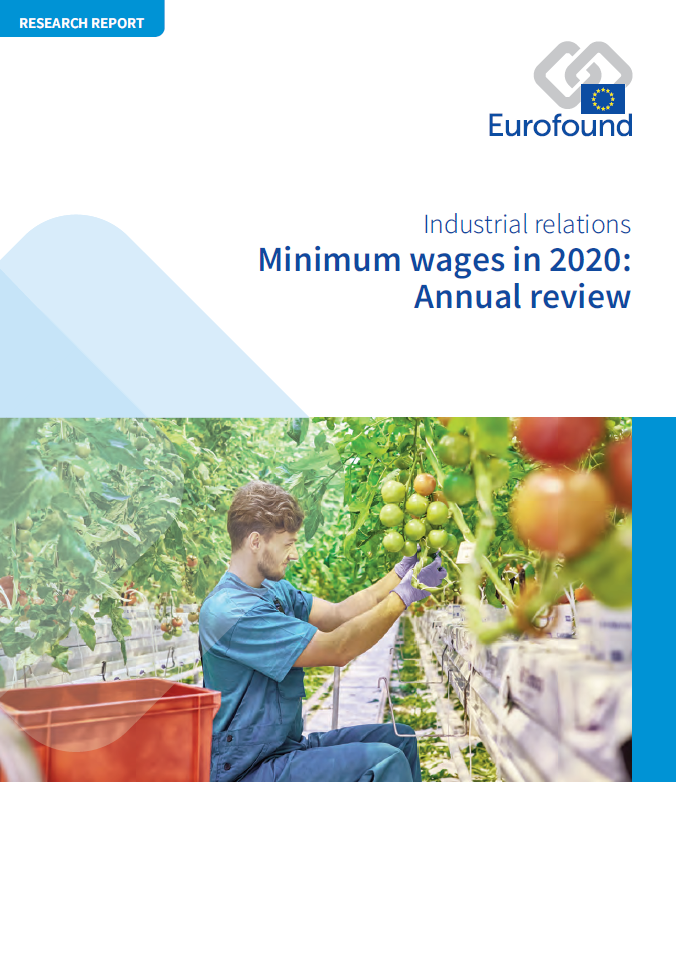
U ovom su izvješću, objavljenom u okviru godišnje serije izdanja o minimalnim plaćama, ukratko predstavljene ključne promjene koje su tijekom 2019. i početkom 2020. obilježile inicijativu EU-a u pogledu pravednih plaća, smještajući u taj kontekst nacionalne rasprave o utvrđivanju njihovih iznosa za 2020. i nakon toga. Izvješće pokazuje kako su minimalne plaće utvrđene i koja je uloga socijalnih partnera. U njemu se analiziraju promjene u zakonskim minimalnim plaćama i navode podatci o iznosima minimalnih plaća u kolektivnim ugovorima za deset slabije plaćenih poslova u zemljama u kojima ne postoje zakonske minimalne plaće. Izvješće sadržava i odjeljak o minimalnim plaćama u regionalnoj perspektivi, a u njemu je predstavljeno posljednje istraživanje o učincima promjena u minimalnim plaćama na plaće općenito, zaposlenost, siromaštvo osoba unatoč zaposlenju, cijene i prihode.
Key findings
Brojne su zemlje 2019. vodile rasprave o dodatnom većem povećanju minimalnih plaća nakon 2020., neke u vezi s relativnom ciljnom vrijednošću, a druge u apsolutnom smislu.
Od početka tisućljeća zakonske su minimalne plaće postale pravednije u usporedbi s plaćama ostalih radnika (kada se zakonske minimalne plaće usporede s medijalnim plaćama svih radnika).
Unatoč tom uzlaznom trendu, minimalne plaće u većini zemalja i dalje iznose manje od 60 %, pa čak i manje od 50 % medijalnih plaća. To posebno vrijedi za središnje i istočne države članice, koje su početkom tisućljeća uvodile minimalne plaće s vrlo niskim relativnim razinama, a ciljne vrijednosti u njihovim propisima o minimalnim plaćama i dalje iznose oko 50 % ili manje.
Ukupno gledajući, sedmero od deset radnika koji primaju minimalnu plaću navodi da, barem u određenoj mjeri, teško spaja kraj s krajem, a kad je riječ o ostalim radnicima, to navodi manje od petero od deset radnika. Međutim, te se brojke znatno razlikuju među zemljama. Tako u Danskoj, Finskoj, Njemačkoj i Švedskoj manje od 10 % radnika koji primaju minimalnu plaću to uspijeva teško do vrlo teško, u usporedbi s između 50 % i 60 % takvih radnika u Bugarskoj, Hrvatskoj i Cipru te čak 80 % u Grčkoj.
Vlade u cijeloj Europi uvode mjere za stabilizaciju dohodaka za one pogođene krizom koju je prouzročila bolest COVID-19. Minimalne plaće mogu imati ulogu u kombinaciji politika čija je svrha stabilizacija dohodaka i potražnje radi sprječavanja pada u recesiju ili depresiju.
Data
Find data on statutory minimum wages in the EU.
- Data: Proportion of minimum wage workers who find it difficult to make ends meet, EU average
- Data: Minimum wage developments in real terms, 15 euro area countries, 2015 price levels
- Data: Proportion of minimum wage workers who find it difficult to make ends meet
- Data: Statutory minimum wages - Minimum wages in the EU in 2020
List of tables
- Table 1: Social partners’ first reactions to the announced initiative on fair wages
- Table 2: Overview of main arguments and proposals concerning an EU minimum wage initiative from social partners
- Table 3: Gross minimum wages, selected EU Member States and the UK, 2019 and 2020
- Table 4: Sub-minimum rates for selected EU Member States and the UK as at 1 January 2020
- Table 5: Further statutory minimum wage rates for private sector workers in selected EU Member States
- Table 6: Number of collective agreements covering low-paying job categories for countries without statutory minimum wages
- Table 7: Minimum wages in collective agreements, applicable in 2019 for selected low-paid jobs
- Table 8: Collective agreement coverage in Finland
- Table 9: Overview of debates during 2019 on aspects of the minimum wage setting processes
- Table 10: Demands for and agreements on targets for future minimum wages to address adequacy in selected EU Member States and the UK
- Table 11: Regional statutory minimum wage rates
- Table 12: Latest minimum wage research in EU Member States and the UK
- Table 13: Overview of recent empirical research in the EU, Norway and the UK on employment impacts of minimum wage increases, 2019
- Table 14: Policies influencing in-work poverty
- Table A1: Network of Eurofound Correspondents – Members participating in the research
List of figures
- Figure 1: Conceptualising adequate minimum wages
- Figure 2: Estimated share of employees earning 90% to 110% of the minimum wage, EU Member States, 2017
- Figure 3: Proportions of female and male employees, EU level, 2017
- Figure 4: Proportion of minimum wage workers per sector, EU level, 2017
- Figure 5: Proportion of minimum wage workers per occupation (top 10), EU level, 2017
- Figure 6: Hourly minimum wages, selected EU Member States, 2020
- Figure 7: Minimum wage developments in real terms, 15 euro area countries, 2015 price levels
- Figure 8: Minimum wage developments in real terms, non-euro area, 2015 price levels
- Figure 9: Impact of purchasing power on the minimum wage value for selected EU Member States and the UK, as at 1 January 2020
- Figure 10: Relative distance between purchasing power of lowest and median minimum wage EU Member States and the UK and highest minimum wage EU Member States and the UK, 2010–2020
- Figure 11: Process for determining minimum wage rates for 2020
- Figure 12: Number of minimum wage rate updates, EU Member States with statutory minimum wages and the UK, since 2010
- Figure 13: Longer-term trend of development of statutory minimum wages relative to median wages of full-time employed workers, selected countries within the EU and the UK, 2000–2018
- Figure 14: Proportion of minimum wage workers who find it difficult to make ends meet, EU average
- Figure 15: Proportion of minimum wage workers who find it difficult to make ends meet
- Figure 16: Making ends meet and minimum wages in relative and absolute terms
- Figure 17: Monthly minimum wage as a proportion of the mean value of average monthly earnings by NUTS1 region, reference year 2016
- Figure 18: Regional variation of relative monthly minimum wages, by NUTS1 region, 2016
- Figure 19: Examples of countries with higher interregional differences in the proportion of minimum wage workers
- Number of pages
-
86
- Reference nº
-
EF20005
- ISBN
-
978-92-897-2068-7
- Catalogue nº
-
TJ-AS-20-001-EN-N
- DOI
-
10.2806/999852
- Permalink
Cite this publication
